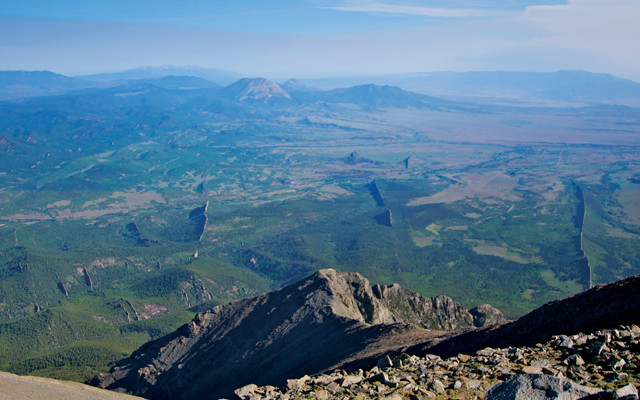
by Mary Caperton Morton Wednesday, September 2, 2015

The remnants of numerous sills of solidified magma radiate from West Spanish Peak in Colorado. New research suggests that the formation of new sills underground may play a role in triggering volcanic eruptions. Credit: Mary Caperton Morton.
What makes a volcano erupt? Over the years, scientists have proposed a litany of potential triggers, but there’s always room for one more. With help from dyed water, a laser and a tank of clear jelly, researchers have proposed a new mechanism that might push loaded volcanoes toward eruption.
Before a volcano erupts, magma welling up through the crust has to make its way to the surface through a series of vertical and horizontal conduits called dikes and sills. Exactly how these channels form remains something of a mystery due to the difficulty and danger of studying such massive underground structures in the field. In the new work, scientists built a scaled-down laboratory model using gelatin to mimic crustal rocks and dye-colored water as a stand-in for magma to shed light on the process.
“In our experiment, we don’t actually create an eruption. We’re specifically interested in looking at the initial stages of how a magma chamber might form in a volcano and the consequences [of that process] for triggering an eruption,” says Janine Kavanagh, a volcanologist at the University of Liverpool in England and lead author of the new study published in Earth and Planetary Science Letters.
As magma rises to the surface through vertical dikes, occasionally it turns and travels sideways, forming a horizontal sill. “We think magma chambers might form from the accretion of multiple sills, when stacks of horizontal magma bodies build upon one another together, creating a larger chamber,” she says.
In their experiment, Kavanagh and colleagues used a high-speed camera and a motion-sensing laser to track the dyed water as it moved through the gelatin. In the moment that the water ascending through a dike in the gelatin began forming a sill, they noticed a sudden, never-before-observed drop in pressure in the system.
“Anytime you see a sudden drop in pressure during magma propagation, you wonder what might happen next,” says Eleonora Rivalta, a geophysicist at the GFZ German Research Center for Geosciences in Potsdam, who was not involved in the new study. Such pressure drops can cause gases dissolved in magma to rapidly bubble out of solution, Rivalta says.
If the pressure on magma decreases rapidly and these dissolved gases boil suddenly, this can create “a large expansion in volume, more cracks in the surrounding rock and a very buoyant fluid, which can rise to the surface and potentially trigger an eruption,” Kavanagh says. “This drop in pressure could happen in many types of volcanoes around the world when new sills form, but whether that goes on to feed an eruption likely depends on how much magma is available to be mobilized,” she says. In order for the magma to erupt, there has to be enough of it so it doesn’t slow down and solidify on its way up.
“Of course, this is a model based on gelatin and water, but the analog has been well established in other experiments,” Rivalta says. Such models have been used since the 1970s to replicate volcanic eruptions in the lab.
Using the laser enabled the team to track movement and detect pressure changes in the simulated magma, Kavanagh says, because the laser caused tiny particles in the jelly to fluoresce. The next step will be to look for similar pressure drops in the field using existing seismic volcano monitoring networks, as well as ground- and satellite-based methods that record surface deformation, she says.
However, observing the moment of sill formation in the field has proved challenging using geophysical methods, Rivalta says. “Inflating and recharging of existing sills has been observed, but that’s not the same process as forming a new sill.”
With more than 600 million people living near active volcanoes, Kavanagh says, “understanding the triggers for volcanic eruptions is vital for forecasting efforts, hazard assessment and risk mitigation.”
© 2008-2021. All rights reserved. Any copying, redistribution or retransmission of any of the contents of this service without the expressed written permission of the American Geosciences Institute is expressly prohibited. Click here for all copyright requests.